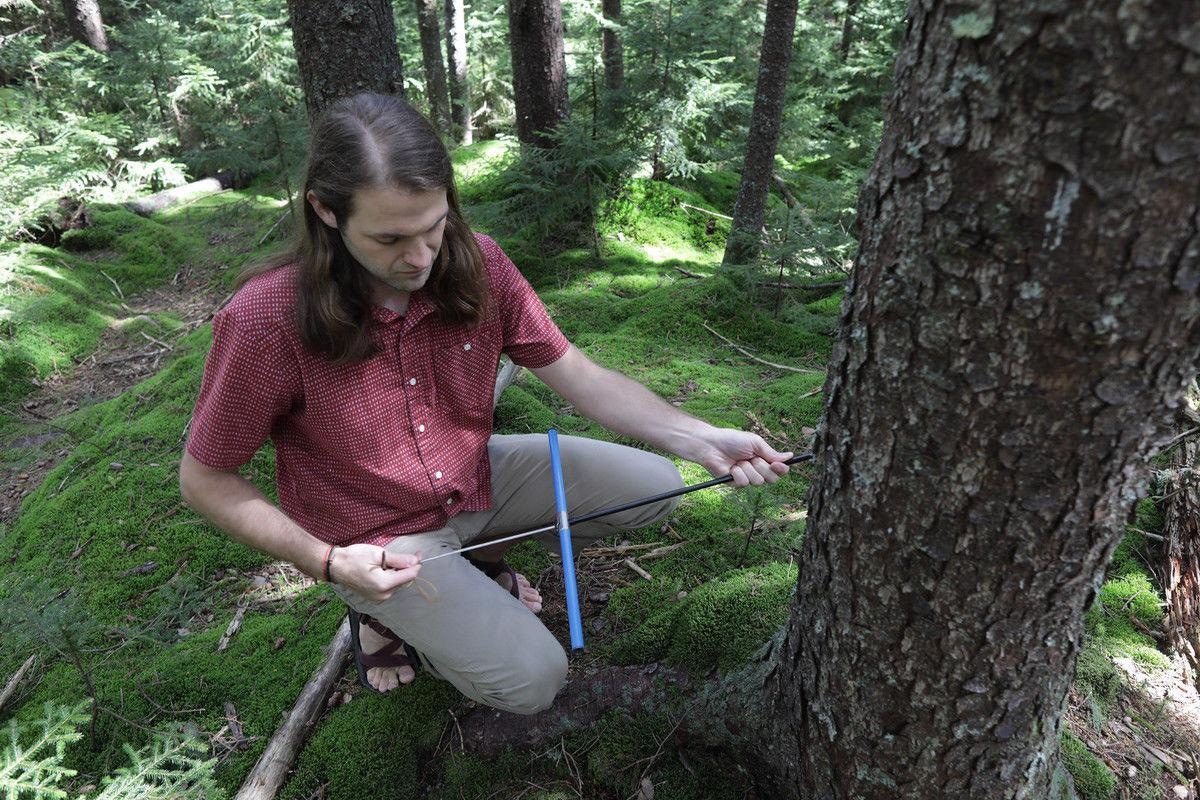Feb 9 2021
A new study by biologists from West Virginia University (WVU) has demonstrated that trees across the globe are absorbing more carbon dioxide compared to previous reports, which makes forests even more significant in controlling Earth’s atmosphere and completely transforming people’s views regarding climate change.
 WVU alumnus Justin Mathias holds a tree increment borer to extract tree cores at Gaudineer Knob in West Virginia. Mathias and Richard Thomas, professor of forest ecology and climate change, found that trees are taking in more carbon dioxide than previously thought in a new study. Image Credit: West Virginia University.
WVU alumnus Justin Mathias holds a tree increment borer to extract tree cores at Gaudineer Knob in West Virginia. Mathias and Richard Thomas, professor of forest ecology and climate change, found that trees are taking in more carbon dioxide than previously thought in a new study. Image Credit: West Virginia University.
Published in the Proceedings of the National Academy of Sciences, the study by Professor Richard Thomas and alumnus Justin Mathias (BS Biology, ’13 and PhD Biology, ’20) synthesized published tree ring studies.
They have discovered that elevated levels of carbon dioxide in the atmosphere in the last century have resulted in an uptrend in the water-use efficiency of trees, or the ratio of carbon dioxide absorbed by photosynthesis to the water lost by transpiration—the act of trees 'breathing out' water vapor.
This study really highlights the role of forests and their ecosystems in climate change. We think of forests as providing ecosystem services. Those services can be a lot of different things – recreation, timber, industry. We demonstrate how forests perform another important service: acting as sinks for carbon dioxide.
Richard Thomas, Professor and Interim Associate Provost for Graduate Academic Affairs, West Virginia University
“Our research shows that forests consume large amounts of carbon dioxide globally. Without that, more carbon dioxide would go into the air and build up in the atmosphere even more than it already is, which could exacerbate climate change. Our work shows yet another important reason to preserve and maintain our forests and keep them healthy,” added Thomas.
Researchers previously believed that trees were efficiently using water in the last century via decreased stomatal conductance—implying trees were keeping more moisture when the pores on their leaves started closing a little under increasing levels of carbon dioxide.
But after an analysis that involved the use of oxygen and carbon isotopes in tree rings from 1901 to 2015, from 36 tree species at 84 sites globally, the researchers discovered that in 83% of cases, the principal driver of the greater water efficiency of trees was increased photosynthesis—they processed more carbon dioxide.
At the same time, the stomatal conductance induced a higher efficiency only 17% of the time. This represents a significant change in how the water efficiency of trees has been described contrary to earlier studies.
We’ve shown that over the past century, photosynthesis is actually the overwhelming driver to increases in tree water use efficiency, which is a surprising result because it contradicts many earlier studies. On a global scale, this will have large implications potentially for the carbon cycle if more carbon is being transferred from the atmosphere into trees.
Justin Mathias, Alumnus, West Virginia University
From 1901, the inherent water use efficiency of trees across the globe has increased by around 40% together with a rise of approximately 34% in atmospheric carbon dioxide. Both these properties increased around four times quicker since the 1960s than in previous years.
Although these findings denote that the rise in carbon dioxide is the significant factor that makes trees use water more efficiently, the findings also differ based on precipitation, temperature, and dryness of the air. Such information can help improve models employed to forecast the impacts of climate change on water cycles and global carbon.
Having an accurate representation of these processes is critical in making sound predictions about what may happen in the future. This helps us get a little closer to making those predictions less uncertain.
Justin Mathias, Alumnus, West Virginia University
The study is the result of a seven-year research collaboration between the researchers when Mathias was a doctoral student. Mathias joined the University of California, Santa Barbara as a postdoctoral researcher after graduating from WVU.
According to Mathias, “Since moving to California, my work has taken a turn from being in the field, collecting measurements, analyzing data and writing manuscripts. My new position is more focused on ecological theory and ecosystem modeling. Instead of measuring plants, I form hypotheses and seek out answers to questions using computer models and math.”
Going forward, Mathias aims to become a professor at a research university to continue pursuing such work.
“I would love to run my own lab at a university, mentor graduate students and pursue research questions to continue building on the work we’ve already accomplished. There’s been a lot of progress in our field,” added Mathias.
“There are also an infinite number of questions that are relevant moving forward. I owe everything to my time and training from the people at WVU. My long-term goal is to be in a position where I can continue moving the field forward while giving back through teaching and mentoring students,” Mathias concluded.
Journal Reference
Mathias, J M & Thomas, R B (2021) Global tree intrinsic water use efficiency is enhanced by increased atmospheric CO2 and modulated by climate and plant functional types. Proceedings of the National Academy of Sciences. doi.org/10.1073/pnas.2014286118.